Tyre pressures JAGUAR XF 2010 1.G Owners Manual
[x] Cancel search | Manufacturer: JAGUAR, Model Year: 2010, Model line: XF, Model: JAGUAR XF 2010 1.GPages: 225, PDF Size: 8 MB
Page 70 of 225
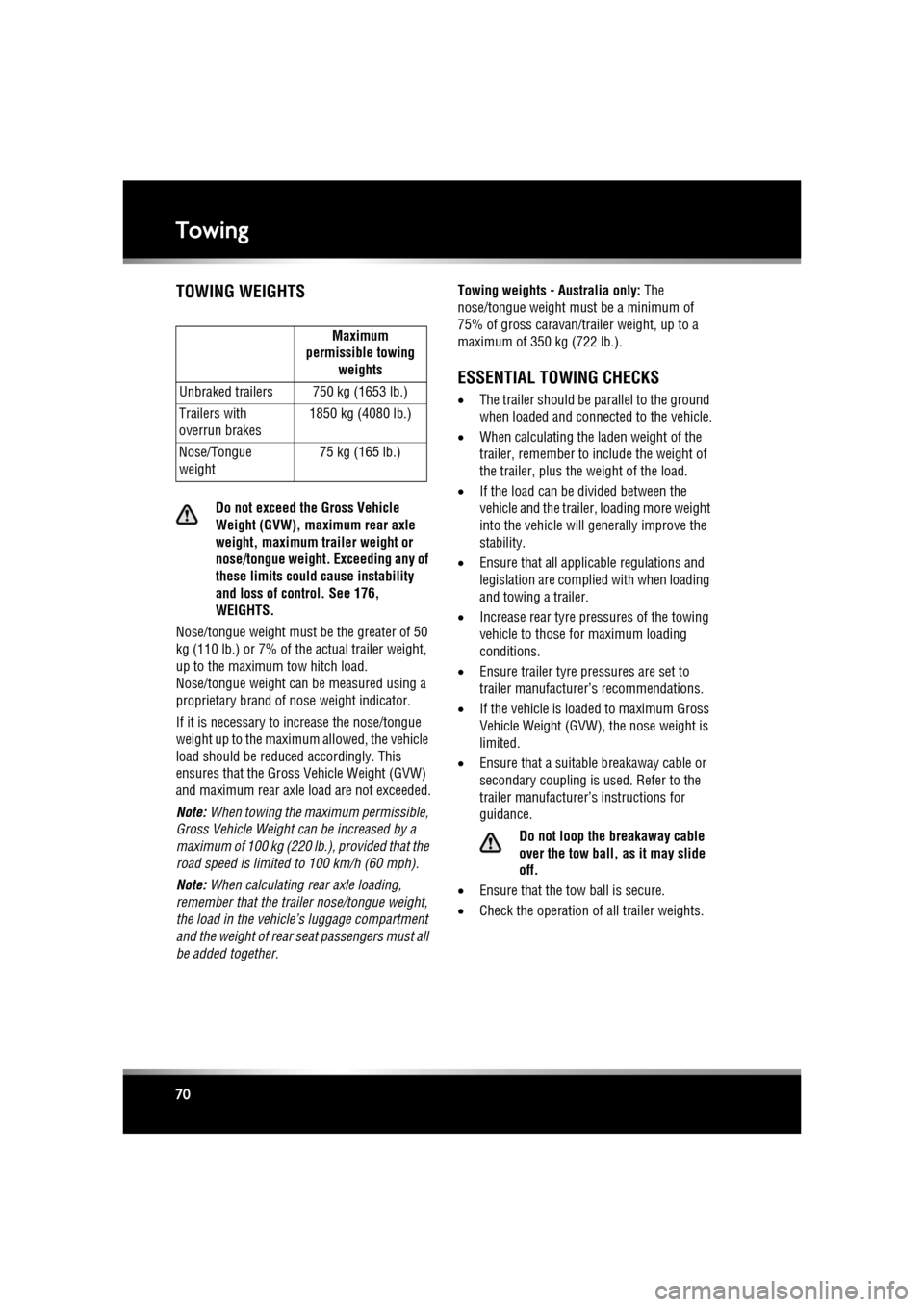
L
(FM8) SEMCON JLR OWNER GUIDE VER 1.00 EURO
LANGUAGE: english-en; MARQUE: jaguar; MODEL: XF
Towing
70
TOWING WEIGHTS
Do not exceed the Gross Vehicle
Weight (GVW), maximum rear axle
weight, maximum trailer weight or
nose/tongue weight. Exceeding any of
these limits could cause instability
and loss of control. See 176,
WEIGHTS.
Nose/tongue weight must be the greater of 50
kg (110 lb.) or 7% of the actual trailer weight,
up to the maximum tow hitch load.
Nose/tongue weight can be measured using a
proprietary brand of nose weight indicator.
If it is necessary to increase the nose/tongue
weight up to the maximum allowed, the vehicle
load should be reduced accordingly. This
ensures that the Gross Vehicle Weight (GVW)
and maximum rear axle load are not exceeded.
Note: When towing the maximum permissible,
Gross Vehicle Weight ca n be increased by a
maximum of 100 kg (220 lb.), provided that the
road speed is limited to 100 km/h (60 mph).
Note: When calculating rear axle loading,
remember that the trailer nose/tongue weight,
the load in the vehicle’s luggage compartment
and the weight of rear se at passengers must all
be added together. Towing weights - Australia only:
The
nose/tongue weight must be a minimum of
75% of gross caravan/trailer weight, up to a
maximum of 350 kg (722 lb.).
ESSENTIAL TOWING CHECKS
• The trailer should be parallel to the ground
when loaded and connected to the vehicle.
• When calculating the laden weight of the
trailer, remember to include the weight of
the trailer, plus the weight of the load.
• If the load can be divided between the
vehicle and the trailer, loading more weight
into the vehicle will generally improve the
stability.
• Ensure that all applic able regulations and
legislation are complied with when loading
and towing a trailer.
• Increase rear tyre pressures of the towing
vehicle to those for maximum loading
conditions.
• Ensure trailer tyre pressures are set to
trailer manufacturer’ s recommendations.
• If the vehicle is loaded to maximum Gross
Vehicle Weight (GVW), the nose weight is
limited.
• Ensure that a suitable breakaway cable or
secondary coupling is used. Refer to the
trailer manufacturer’ s instructions for
guidance.
Do not loop the breakaway cable
over the tow ball, as it may slide
off.
• Ensure that the tow ball is secure.
• Check the operation of all trailer weights.
Maximum
permissible towing weights
Unbraked trailers 750 kg (1653 lb.)
Trailers with
overrun brakes 1850 kg (4080 lb.)
Nose/Tongue
weight 75 kg (165 lb.)
Page 89 of 225
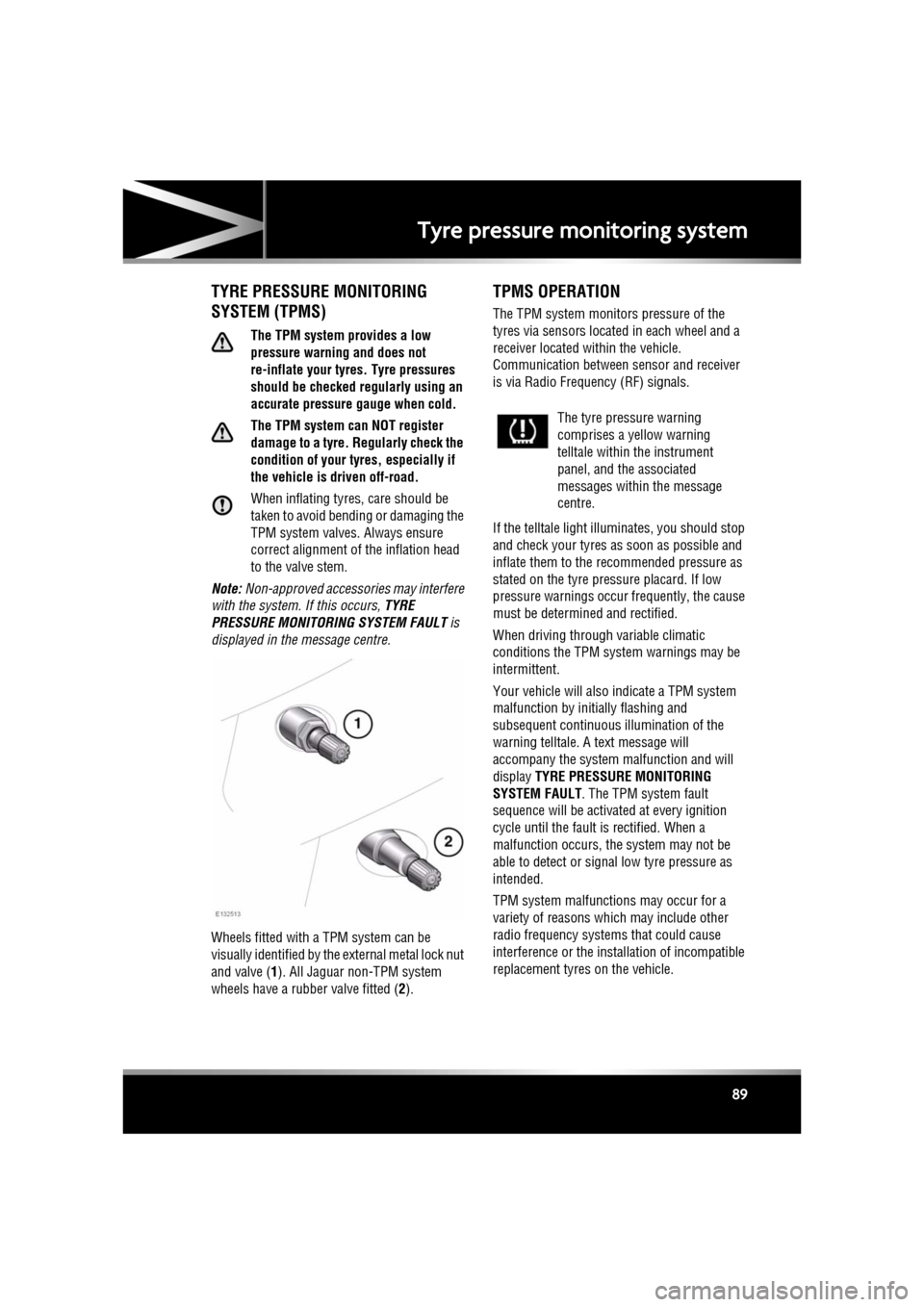
R
(FM8) SEMCON JLR OWNER GUIDE VER 1.00 EURO
LANGUAGE: english-en; MARQUE: jaguar; MODEL: XF
Tyre pressure monitoring system
89
Tyre pressure monitoring systemTYRE PRESSURE MONITORING
SYSTEM (TPMS)
The TPM system provides a low
pressure warning and does not
re-inflate your tyres. Tyre pressures
should be checked regularly using an
accurate pressure gauge when cold.
The TPM system can NOT register
damage to a tyre. Regularly check the
condition of your tyres, especially if
the vehicle is driven off-road.
When inflating tyre s, care should be
taken to avoid bending or damaging the
TPM system valves. Always ensure
correct alignment of the inflation head
to the valve stem.
Note: Non-approved accessories may interfere
with the system. If this occurs, TYRE
PRESSURE MONITORI NG SYSTEM FAULT is
displayed in the message centre.
Wheels fitted with a TPM system can be
visually identified by the external metal lock nut
and valve ( 1). All Jaguar n on-TPM system
wheels have a rubber valve fitted (2).
TPMS OPERATION
The TPM system monitors pressure of the
tyres via sensors located in each wheel and a
receiver located within the vehicle.
Communication between sensor and receiver
is via Radio Freque ncy (RF) signals.
If the telltale light illu minates, you should stop
and check your tyres as soon as possible and
inflate them to the recommended pressure as
stated on the tyre pressure placard. If low
pressure warnings occur frequently, the cause
must be determined and rectified.
When driving through variable climatic
conditions the TPM syst em warnings may be
intermittent.
Your vehicle will also indicate a TPM system
malfunction by initially flashing and
subsequent continuous illumination of the
warning telltale. A text message will
accompany the system malfunction and will
display TYRE PRESSURE MONITORING
SYSTEM FAULT . The TPM system fault
sequence will be activated at every ignition
cycle until the fault is rectified. When a
malfunction occurs, the system may not be
able to detect or signal low tyre pressure as
intended.
TPM system malfuncti ons may occur for a
variety of reasons which may include other
radio frequency systems that could cause
interference or the installation of incompatible
replacement tyres on the vehicle.
The tyre pressure warning
comprises a yellow warning
telltale within the instrument
panel, and the associated
messages within the message
centre.
Page 90 of 225
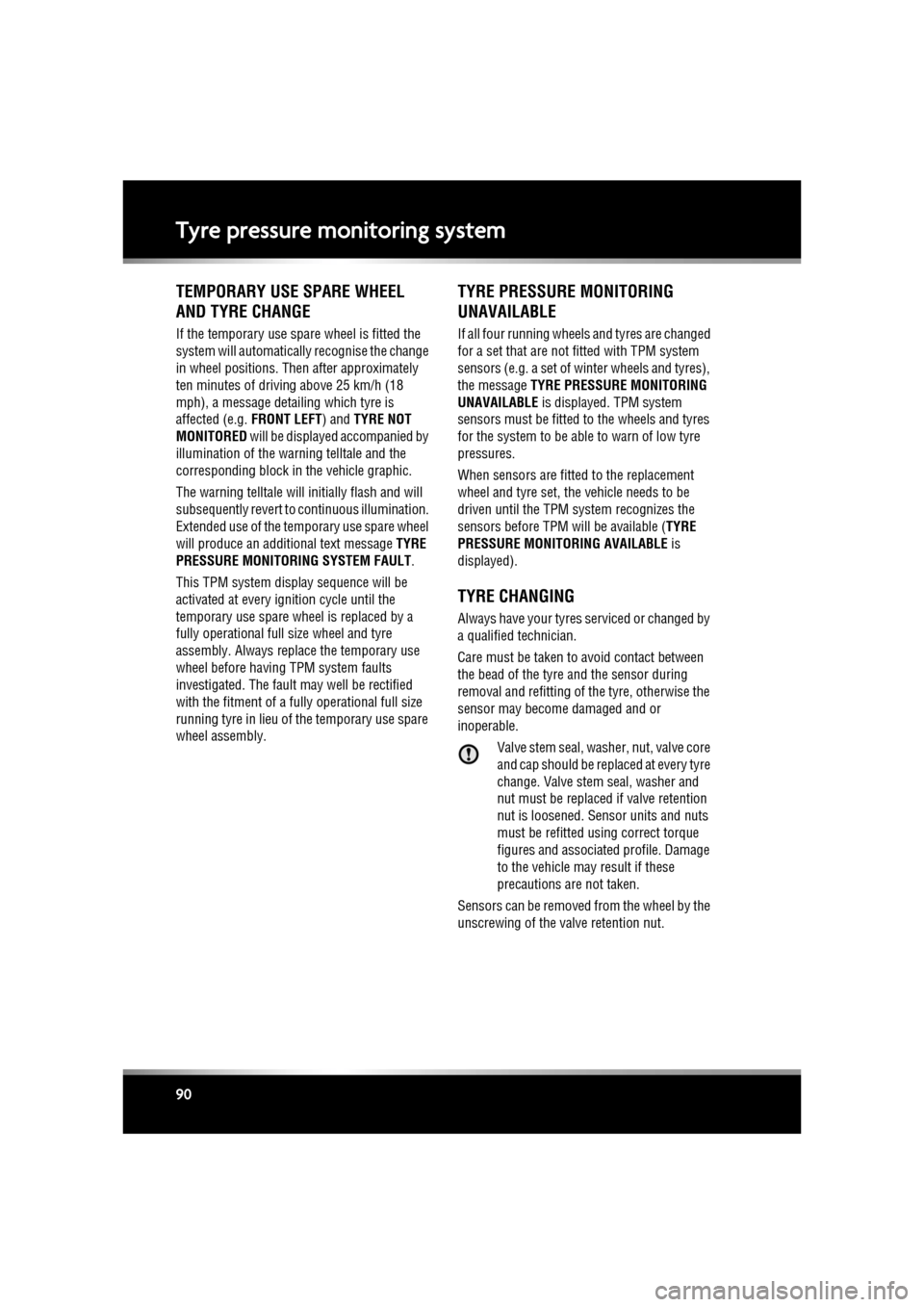
L
(FM8) SEMCON JLR OWNER GUIDE VER 1.00 EURO
LANGUAGE: english-en; MARQUE: jaguar; MODEL: XF
Tyre pressure monitoring system
90
TEMPORARY USE SPARE WHEEL
AND TYRE CHANGE
If the temporary use spare wheel is fitted the
system will automatically recognise the change
in wheel positions. The n after approximately
ten minutes of drivin g above 25 km/h (18
mph), a message deta iling which tyre is
affected (e.g. FRONT LEFT) and TYRE NOT
MONITORED will be displayed accompanied by
illumination of the warning telltale and the
corresponding block in the vehicle graphic.
The warning telltale will initially flash and will
subsequently revert to continuous illumination.
Extended use of the temporary use spare wheel
will produce an additional text message TYRE
PRESSURE MONITORING SYSTEM FAULT .
This TPM system display sequence will be
activated at every ignition cycle until the
temporary use spare wheel is replaced by a
fully operational full size wheel and tyre
assembly. Always replace the temporary use
wheel before having TPM system faults
investigated. The fault may well be rectified
with the fitment of a fu lly operational full size
running tyre in lieu of the temporary use spare
wheel assembly.
TYRE PRESSURE MONITORING
UNAVAILABLE
If all four running wheels and tyres are changed
for a set that are not fitted with TPM system
sensors (e.g. a set of winter wheels and tyres),
the message TYRE PRESSURE MONITORING
UNAVAILABLE is displayed. TPM system
sensors must be fitted to the wheels and tyres
for the system to be able to warn of low tyre
pressures.
When sensors are fitted to the replacement
wheel and tyre set, the vehicle needs to be
driven until the TPM system recognizes the
sensors before TPM will be available ( TYRE
PRESSURE MONITORING AVAILABLE is
displayed).
TYRE CHANGING
Always have your tyres serviced or changed by
a qualified technician.
Care must be taken to avoid contact between
the bead of the tyre and the sensor during
removal and refitting of the tyre, otherwise the
sensor may become damaged and or
inoperable.
Valve stem seal, washer, nut, valve core
and cap should be repl aced at every tyre
change. Valve stem seal, washer and
nut must be replaced if valve retention
nut is loosened. Sensor units and nuts
must be refitted using correct torque
figures and associated profile. Damage
to the vehicle may result if these
precautions are not taken.
Sensors can be removed from the wheel by the
unscrewing of the va lve retention nut.
Page 158 of 225
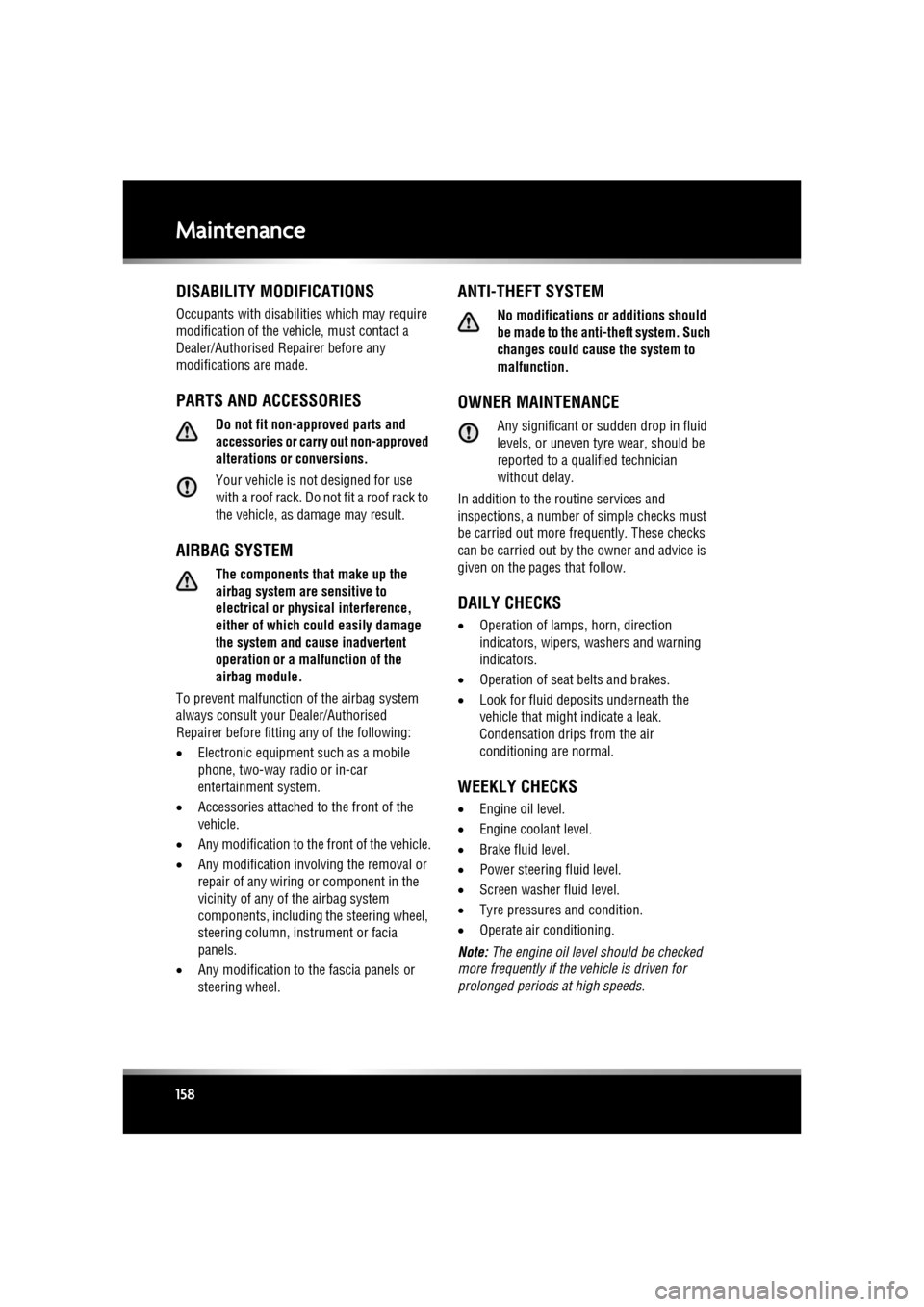
L
(FM8) SEMCON JLR OWNER GUIDE VER 1.00 EURO
LANGUAGE: english-en; MARQUE: jaguar; MODEL: XF
Maintenance
158
MaintenanceDISABILITY MODIFICATIONS
Occupants with disabilities which may require
modification of the vehicle, must contact a
Dealer/Authorised Repairer before any
modifications are made.
PARTS AND ACCESSORIES
Do not fit non-approved parts and
accessories or carry out non-approved
alterations or conversions.
Your vehicle is not designed for use
with a roof rack. Do not fit a roof rack to
the vehicle, as damage may result.
AIRBAG SYSTEM
The components that make up the
airbag system are sensitive to
electrical or phys ical interference,
either of which could easily damage
the system and cause inadvertent
operation or a malfunction of the
airbag module.
To prevent malfunction of the airbag system
always consult your Dealer/Authorised
Repairer before fitting any of the following:
• Electronic equipment such as a mobile
phone, two-way radio or in-car
entertainment system.
• Accessories attached to the front of the
vehicle.
• Any modification to the front of the vehicle.
• Any modification involving the removal or
repair of any wiring or component in the
vicinity of any of the airbag system
components, including the steering wheel,
steering column, instrument or facia
panels.
• Any modification to th e fascia panels or
steering wheel.
ANTI-THEFT SYSTEM
No modifications or additions should
be made to the anti- theft system. Such
changes could cause the system to
malfunction.
OWNER MAINTENANCE
Any significant or sudden drop in fluid
levels, or uneven ty re wear, should be
reported to a qualified technician
without delay.
In addition to the routine services and
inspections, a number of simple checks must
be carried out more fr equently. These checks
can be carried out by th e owner and advice is
given on the pages that follow.
DAILY CHECKS
• Operation of lamps, horn, direction
indicators, wipers, washers and warning
indicators.
• Operation of seat belts and brakes.
• Look for fluid deposits underneath the
vehicle that might indicate a leak.
Condensation drips from the air
conditioning are normal.
WEEKLY CHECKS
•Engine oil level.
• Engine coolant level.
• Brake fluid level.
• Power steering fluid level.
• Screen washer fluid level.
• Tyre pressures and condition.
• Operate air conditioning.
Note: The engine oil leve l should be checked
more frequently if the vehicle is driven for
prolonged periods at high speeds.
Page 176 of 225
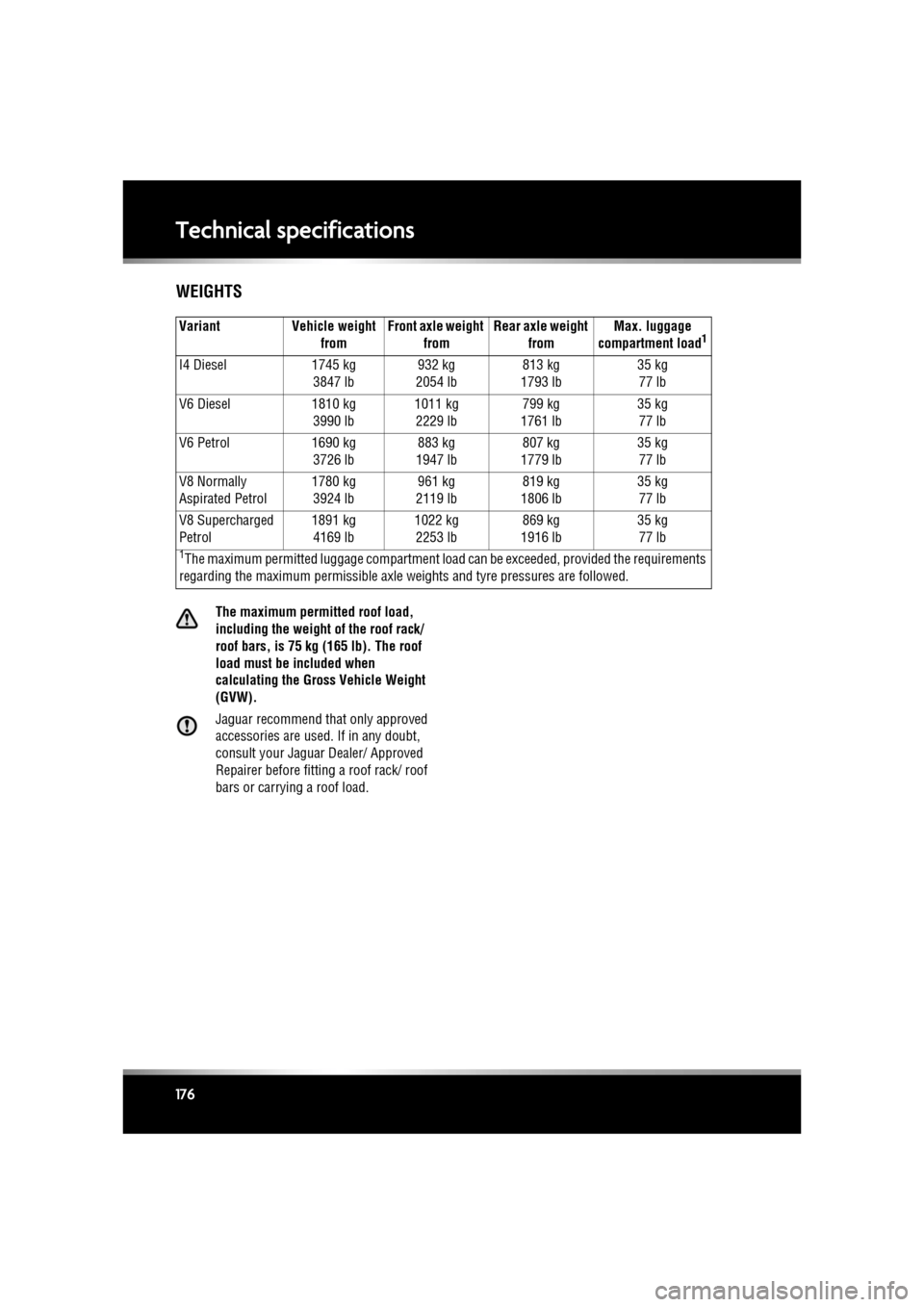
L
(FM8) SEMCON JLR OWNER GUIDE VER 1.00 EURO
LANGUAGE: english-en; MARQUE: jaguar; MODEL: XF
Technical specifications
176
WEIGHTS
The maximum permitted roof load,
including the weight of the roof rack/
roof bars, is 75 kg (165 lb). The roof
load must be included when
calculating the Gross Vehicle Weight
(GVW).
Jaguar recommend that only approved
accessories are used. If in any doubt,
consult your Jaguar Dealer/ Approved
Repairer before fitting a roof rack/ roof
bars or carrying a roof load.
Variant Vehicle weight
fromFront axle weight
from Rear axle weight
from Max. luggage
compartment load
1
I4 Diesel 1745 kg
3847 lb 932 kg
2054 lb 813 kg
1793 lb 35 kg
77 lb
V6 Diesel 1810 kg
3990 lb 1011 kg
2229 lb 799 kg
1761 lb 35 kg
77 lb
V6 Petrol 1690 kg
3726 lb 883 kg
1947 lb 807 kg
1779 lb 35 kg
77 lb
V8 Normally
Aspirated Petrol 1780 kg
3924 lb 961 kg
2119 lb 819 kg
1806 lb 35 kg
77 lb
V8 Supercharged
Petrol 1891 kg
4169 lb 1022 kg
2253 lb 869 kg
1916 lb 35 kg
77 lb
1The maximum permitted luggage co mpartment load can be exceeded, provided the requirements
regarding the maximum permissible axle weights and tyre pressures are followed.
Page 185 of 225
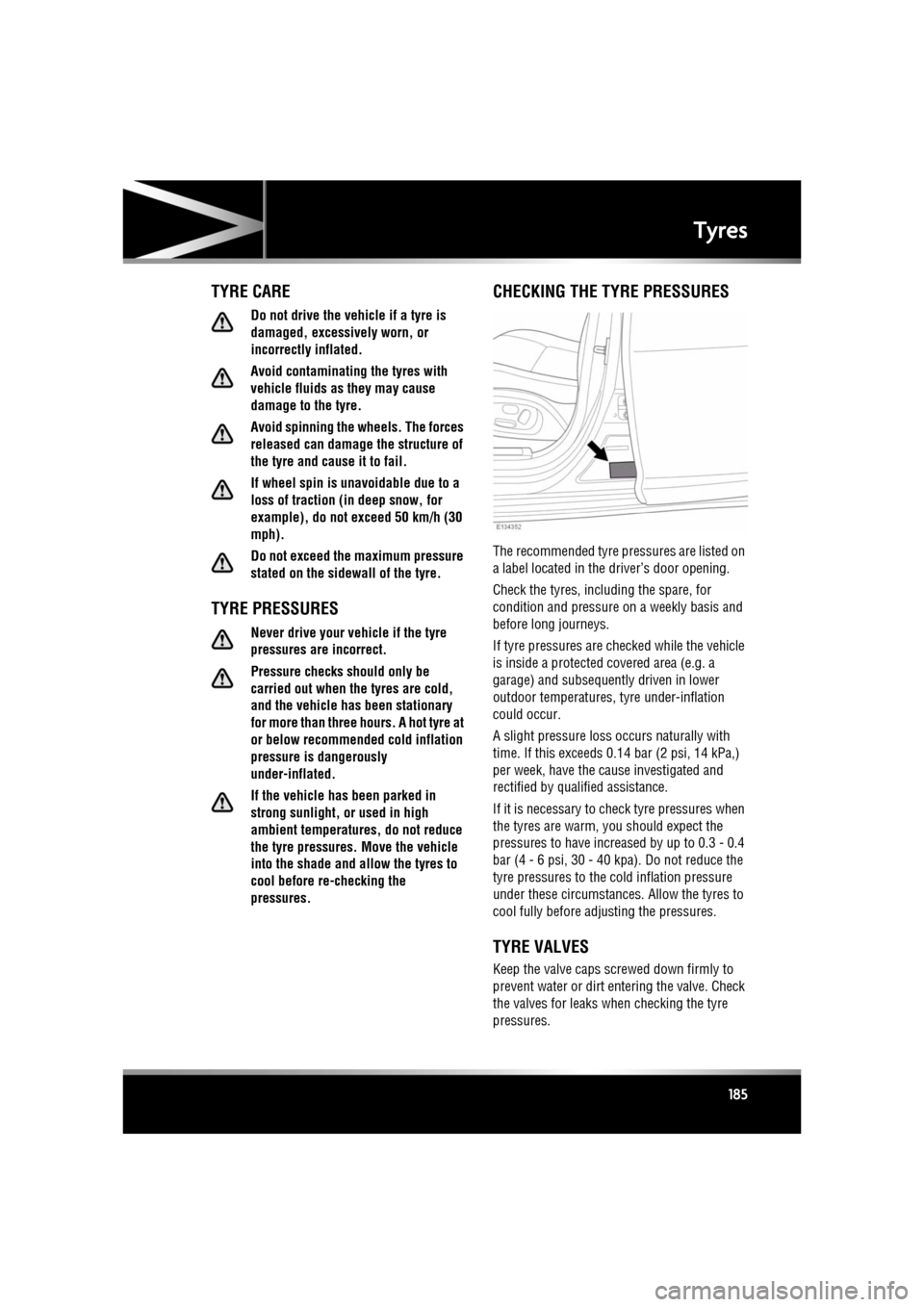
R
(FM8) SEMCON JLR OWNER GUIDE VER 1.00 EURO
LANGUAGE: english-en; MARQUE: jaguar; MODEL: XF
Tyres
185
TyresTYRE CARE
Do not drive the vehi cle if a tyre is
damaged, excessively worn, or
incorrectly inflated.
Avoid contaminating the tyres with
vehicle fluids as they may cause
damage to the tyre.
Avoid spinning the wheels. The forces
released can damage the structure of
the tyre and cause it to fail.
If wheel spin is unavoidable due to a
loss of traction (in deep snow, for
example), do not exceed 50 km/h (30
mph).
Do not exceed the maximum pressure
stated on the sidewall of the tyre.
TYRE PRESSURES
Never drive your vehicle if the tyre
pressures are incorrect.
Pressure checks should only be
carried out when the tyres are cold,
and the vehicle has been stationary
for more than three hours. A hot tyre at
or below recommended cold inflation
pressure is dangerously
under-inflated.
If the vehicle has been parked in
strong sunlight, or used in high
ambient temperatures, do not reduce
the tyre pressures. Move the vehicle
into the shade and allow the tyres to
cool before re-checking the
pressures.
CHECKING THE TYRE PRESSURES
The recommended tyre pressures are listed on
a label located in the driver’s door opening.
Check the tyres, including the spare, for
condition and pressure on a weekly basis and
before long journeys.
If tyre pressures are checked while the vehicle
is inside a protected covered area (e.g. a
garage) and subsequent ly driven in lower
outdoor temperatures, tyre under-inflation
could occur.
A slight pressure loss occurs naturally with
time. If this exceeds 0. 14 bar (2 psi, 14 kPa,)
per week, have the cause investigated and
rectified by qualified assistance.
If it is necessary to check tyre pressures when
the tyres are warm, you should expect the
pressures to have increased by up to 0.3 - 0.4
bar (4 - 6 psi, 30 - 40 kpa). Do not reduce the
tyre pressures to the cold inflation pressure
under these circumstances. Allow the tyres to
cool fully before ad justing the pressures.
TYRE VALVES
Keep the valve caps screwed down firmly to
prevent water or dirt entering the valve. Check
the valves for leaks when checking the tyre
pressures.
Page 186 of 225
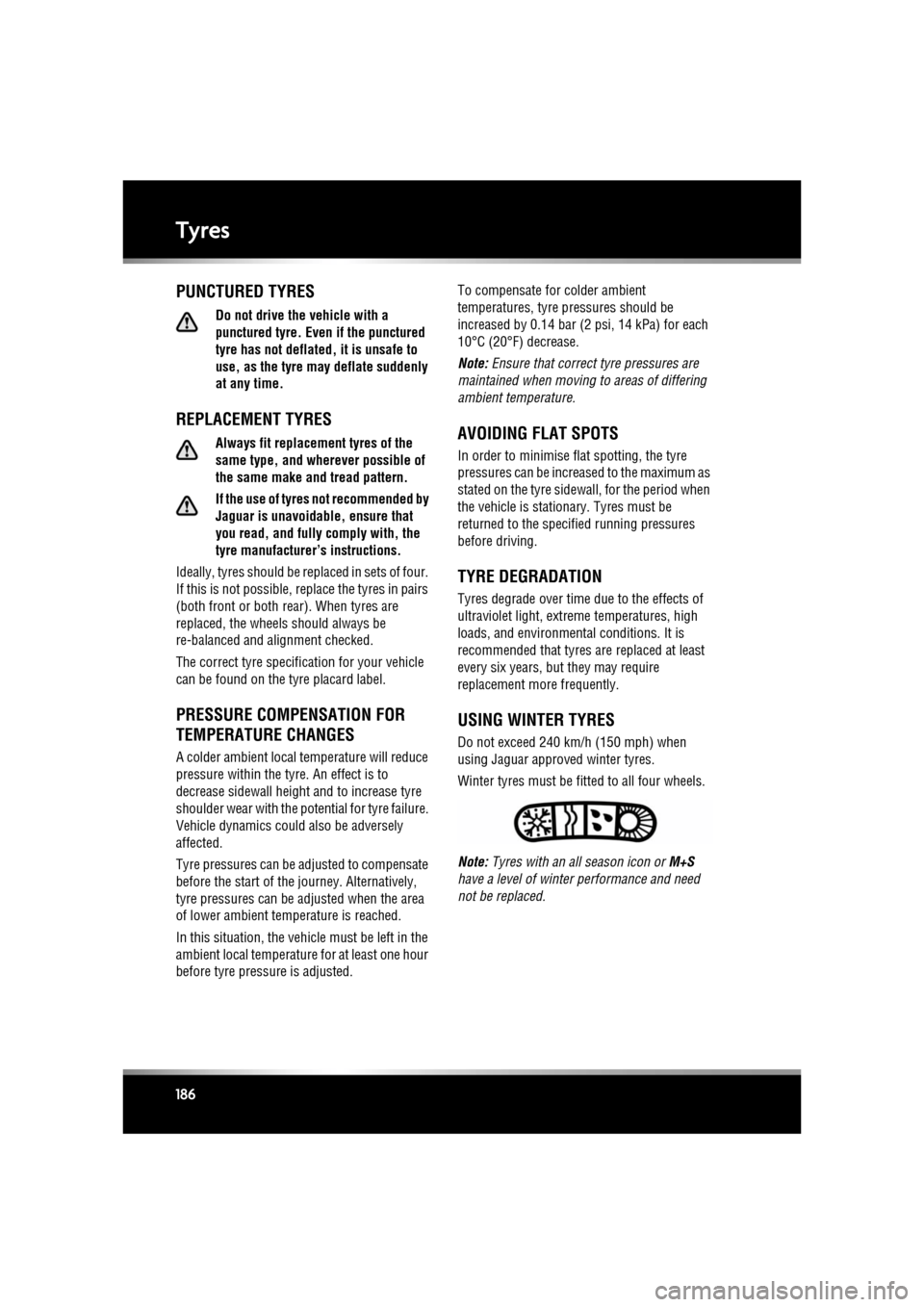
L
(FM8) SEMCON JLR OWNER GUIDE VER 1.00 EURO
LANGUAGE: english-en; MARQUE: jaguar; MODEL: XF
Tyres
186
PUNCTURED TYRES
Do not drive the vehicle with a
punctured tyre. Even if the punctured
tyre has not deflated, it is unsafe to
use, as the tyre may deflate suddenly
at any time.
REPLACEMENT TYRES
Always fit replacement tyres of the
same type, and wherever possible of
the same make and tread pattern.
If the use of tyres not recommended by
Jaguar is unavoidable, ensure that
you read, and fully comply with, the
tyre manufacturer’s instructions.
Ideally, tyres should be re placed in sets of four.
If this is not possible, replace the tyres in pairs
(both front or both rear). When tyres are
replaced, the wheels should always be
re-balanced and alignment checked.
The correct tyre specification for your vehicle
can be found on the ty re placard label.
PRESSURE COMPENSATION FOR
TEMPERATURE CHANGES
A colder ambient local temperature will reduce
pressure within the tyre. An effect is to
decrease sidewall height and to increase tyre
shoulder wear with the potential for tyre failure.
Vehicle dynamics could also be adversely
affected.
Tyre pressures can be adjusted to compensate
before the start of the journey. Alternatively,
tyre pressures can be adjusted when the area
of lower ambient temperature is reached.
In this situation, the vehicle must be left in the
ambient local temperature for at least one hour
before tyre pressure is adjusted. To compensate for colder ambient
temperatures, tyre pressures should be
increased by 0.14 bar (2 psi, 14 kPa) for each
10°C (20°F) decrease.
Note:
Ensure that correct tyre pressures are
maintained when moving to areas of differing
ambient temperature.
AVOIDING FLAT SPOTS
In order to minimise fl at spotting, the tyre
pressures can be increased to the maximum as
stated on the tyre sidewall, for the period when
the vehicle is stationary. Tyres must be
returned to the specified running pressures
before driving.
TYRE DEGRADATION
Tyres degrade over time due to the effects of
ultraviolet light, extreme temperatures, high
loads, and environmen tal conditions. It is
recommended that tyres are replaced at least
every six years, but they may require
replacement more frequently.
USING WINTER TYRES
Do not exceed 240 km/h (150 mph) when
using Jaguar approv ed winter tyres.
Winter tyres must be fitted to all four wheels.
Note: Tyres with an all season icon or M+S
have a level of winter performance and need
not be replaced.
Page 187 of 225
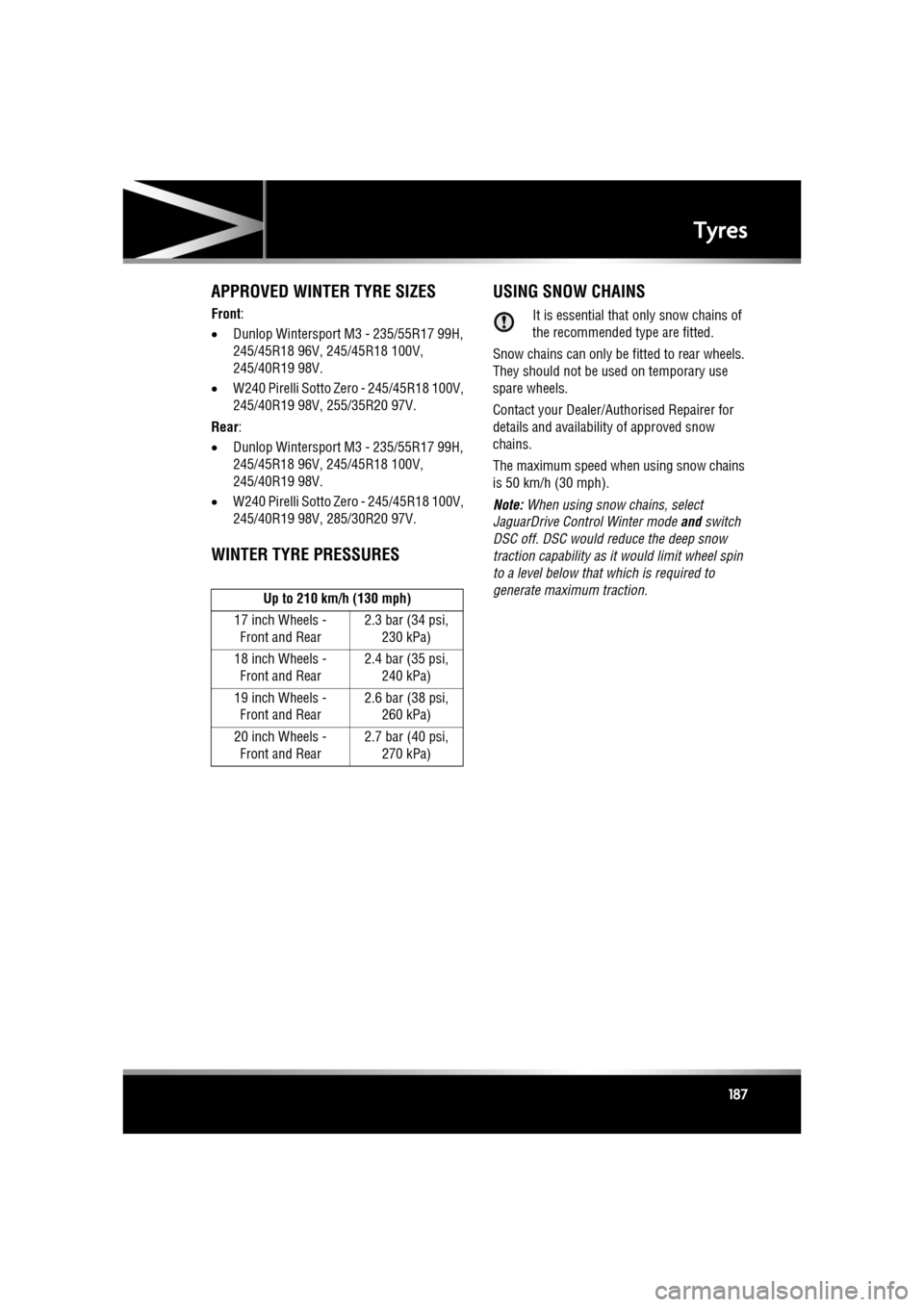
R
(FM8) SEMCON JLR OWNER GUIDE VER 1.00 EURO
LANGUAGE: english-en; MARQUE: jaguar; MODEL: XF
Tyres
187
APPROVED WINTER TYRE SIZES
Front :
• Dunlop Wintersport M3 - 235/55R17 99H,
245/45R18 96V, 245/45R18 100V,
245/40R19 98V.
• W240 Pirelli Sotto Zero - 245/45R18 100V,
245/40R19 98V, 255/35R20 97V.
Rear:
• Dunlop Wintersport M3 - 235/55R17 99H,
245/45R18 96V, 245/45R18 100V,
245/40R19 98V.
• W240 Pirelli Sotto Zero - 245/45R18 100V,
245/40R19 98V, 285/30R20 97V.
WINTER TYRE PRESSURES USING SNOW CHAINS
It is essential that
only snow chains of
the recommended type are fitted.
Snow chains can only be fitted to rear wheels.
They should not be used on temporary use
spare wheels.
Contact your Dealer/Authorised Repairer for
details and availabilit y of approved snow
chains.
The maximum speed when using snow chains
is 50 km/h (30 mph).
Note: When using snow chains, select
JaguarDrive Contro l Winter mode and switch
DSC off. DSC would reduce the deep snow
traction capability as it would limit wheel spin
to a level below that which is required to
generate maximum traction.
Up to 210 km/h (130 mph)
17 inch Wheels - Front and Rear 2.3 bar (34 psi,
230 kPa)
18 inch Wheels - Front and Rear 2.4 bar (35 psi,
240 kPa)
19 inch Wheels - Front and Rear 2.6 bar (38 psi,
260 kPa)
20 inch Wheels - Front and Rear 2.7 bar (40 psi,
270 kPa)
Page 213 of 225
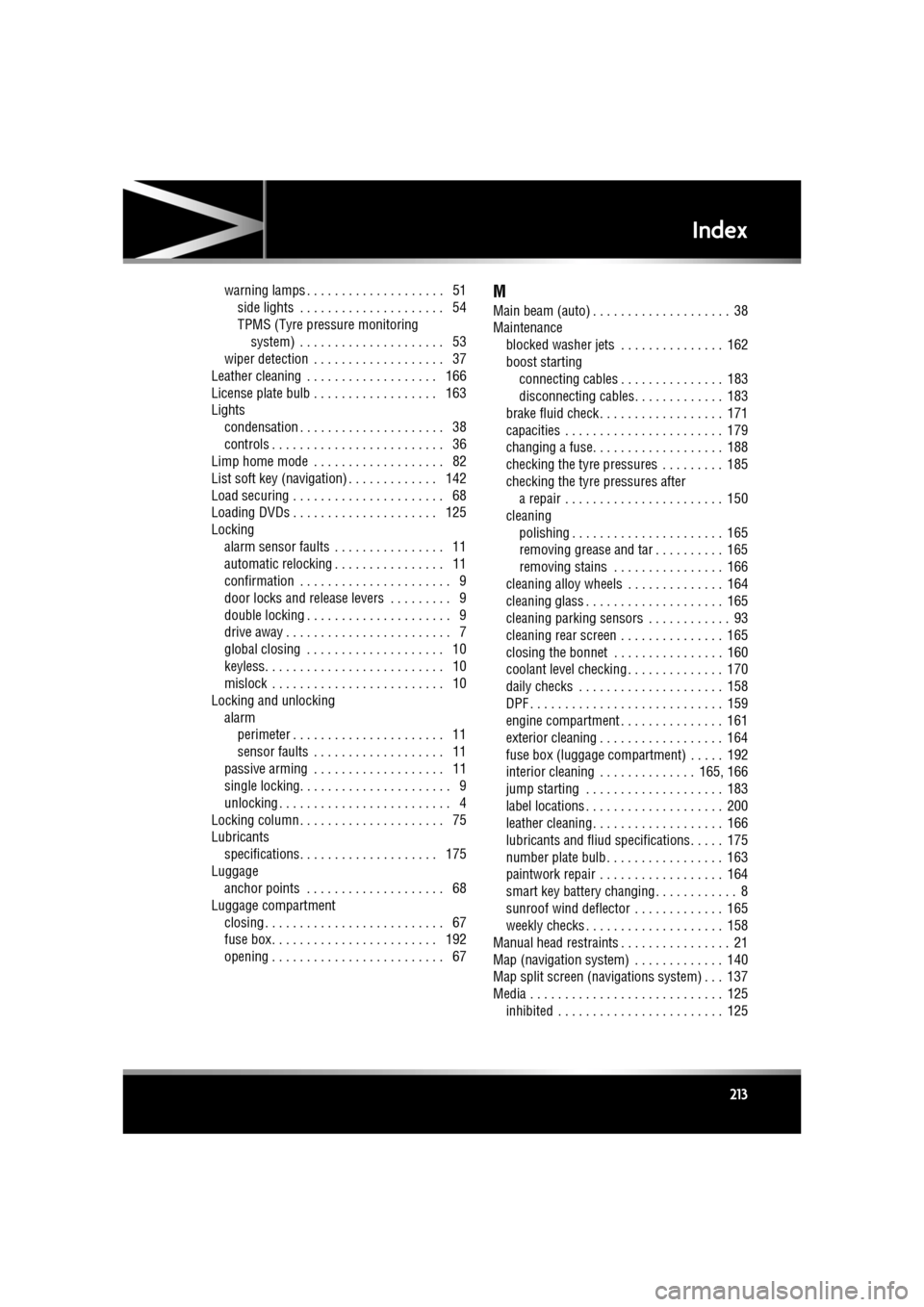
R
english-en (10, 18, 21 & 25)
Index
213
warning lamps . . . . . . . . . . . . . . . . . . . . 51side lights . . . . . . . . . . . . . . . . . . . . . 54
TPMS (Tyre pressure monitoring system) . . . . . . . . . . . . . . . . . . . . . 53
wiper detection . . . . . . . . . . . . . . . . . . . 37
Leather cleaning . . . . . . . . . . . . . . . . . . . 166
License plate bulb . . . . . . . . . . . . . . . . . . 163
Lights condensation . . . . . . . . . . . . . . . . . . . . . 38
controls . . . . . . . . . . . . . . . . . . . . . . . . . 36
Limp home mode . . . . . . . . . . . . . . . . . . . 82
List soft key (navigation) . . . . . . . . . . . . . 142
Load securing . . . . . . . . . . . . . . . . . . . . . . 68
Loading DVDs . . . . . . . . . . . . . . . . . . . . . 125
Locking
alarm sensor faults . . . . . . . . . . . . . . . . 11
automatic relocking . . . . . . . . . . . . . . . . 11
confirmation . . . . . . . . . . . . . . . . . . . . . . 9
door locks and release leve rs . . . . . . . . . 9
double locking . . . . . . . . . . . . . . . . . . . . . 9
drive away . . . . . . . . . . . . . . . . . . . . . . . . 7
global closing . . . . . . . . . . . . . . . . . . . . 10
keyless. . . . . . . . . . . . . . . . . . . . . . . . . . 10
mislock . . . . . . . . . . . . . . . . . . . . . . . . . 10
Locking and unlocking alarmperimeter . . . . . . . . . . . . . . . . . . . . . . 11
sensor faults . . . . . . . . . . . . . . . . . . . 11
passive arming . . . . . . . . . . . . . . . . . . . 11
single locking. . . . . . . . . . . . . . . . . . . . . . 9
unlocking . . . . . . . . . . . . . . . . . . . . . . . . . 4
Locking column . . . . . . . . . . . . . . . . . . . . . 75
Lubricants
specifications. . . . . . . . . . . . . . . . . . . . 175
Luggage anchor points . . . . . . . . . . . . . . . . . . . . 68
Luggage compartment closing . . . . . . . . . . . . . . . . . . . . . . . . . . 67
fuse box . . . . . . . . . . . . . . . . . . . . . . . . 192
opening . . . . . . . . . . . . . . . . . . . . . . . . . 67M
Main beam (auto) . . . . . . . . . . . . . . . . . . . . 38
Maintenance
blocked washer jets . . . . . . . . . . . . . . . 162
boost starting connecting cables . . . . . . . . . . . . . . . 183
disconnecting cables. . . . . . . . . . . . . 183
brake fluid check . . . . . . . . . . . . . . . . . . 171
capacities . . . . . . . . . . . . . . . . . . . . . . . 179
changing a fuse. . . . . . . . . . . . . . . . . . . 188
checking the tyre pressures . . . . . . . . . 185
checking the tyre pressures after a repair . . . . . . . . . . . . . . . . . . . . . . . 150
cleaning
polishing . . . . . . . . . . . . . . . . . . . . . . 165
removing grease and tar . . . . . . . . . . 165
removing stains . . . . . . . . . . . . . . . . 166
cleaning alloy wheels . . . . . . . . . . . . . . 164
cleaning glass . . . . . . . . . . . . . . . . . . . . 165
cleaning parking sensors . . . . . . . . . . . . 93
cleaning rear screen . . . . . . . . . . . . . . . 165
closing the bonnet . . . . . . . . . . . . . . . . 160
coolant level checking . . . . . . . . . . . . . . 170
daily checks . . . . . . . . . . . . . . . . . . . . . 158
DPF . . . . . . . . . . . . . . . . . . . . . . . . . . . . 159
engine compartment . . . . . . . . . . . . . . . 161
exterior cleaning . . . . . . . . . . . . . . . . . . 164
fuse box (luggage compartment) . . . . . 192
interior cleaning . . . . . . . . . . . . . . 165, 166
jump starting . . . . . . . . . . . . . . . . . . . . 183
label locations . . . . . . . . . . . . . . . . . . . . 200
leather cleaning. . . . . . . . . . . . . . . . . . . 166
lubricants and fliud sp ecifications. . . . . 175
number plate bulb . . . . . . . . . . . . . . . . . 163
paintwork repair . . . . . . . . . . . . . . . . . . 164
smart key battery changing. . . . . . . . . . . . 8
sunroof wind deflector . . . . . . . . . . . . . 165
weekly checks . . . . . . . . . . . . . . . . . . . . 158
Manual head restraints . . . . . . . . . . . . . . . . 21
Map (navigation system) . . . . . . . . . . . . . 140
Map split screen (navigations system) . . . 137
Media . . . . . . . . . . . . . . . . . . . . . . . . . . . . 125 inhibited . . . . . . . . . . . . . . . . . . . . . . . . 125
Page 215 of 225
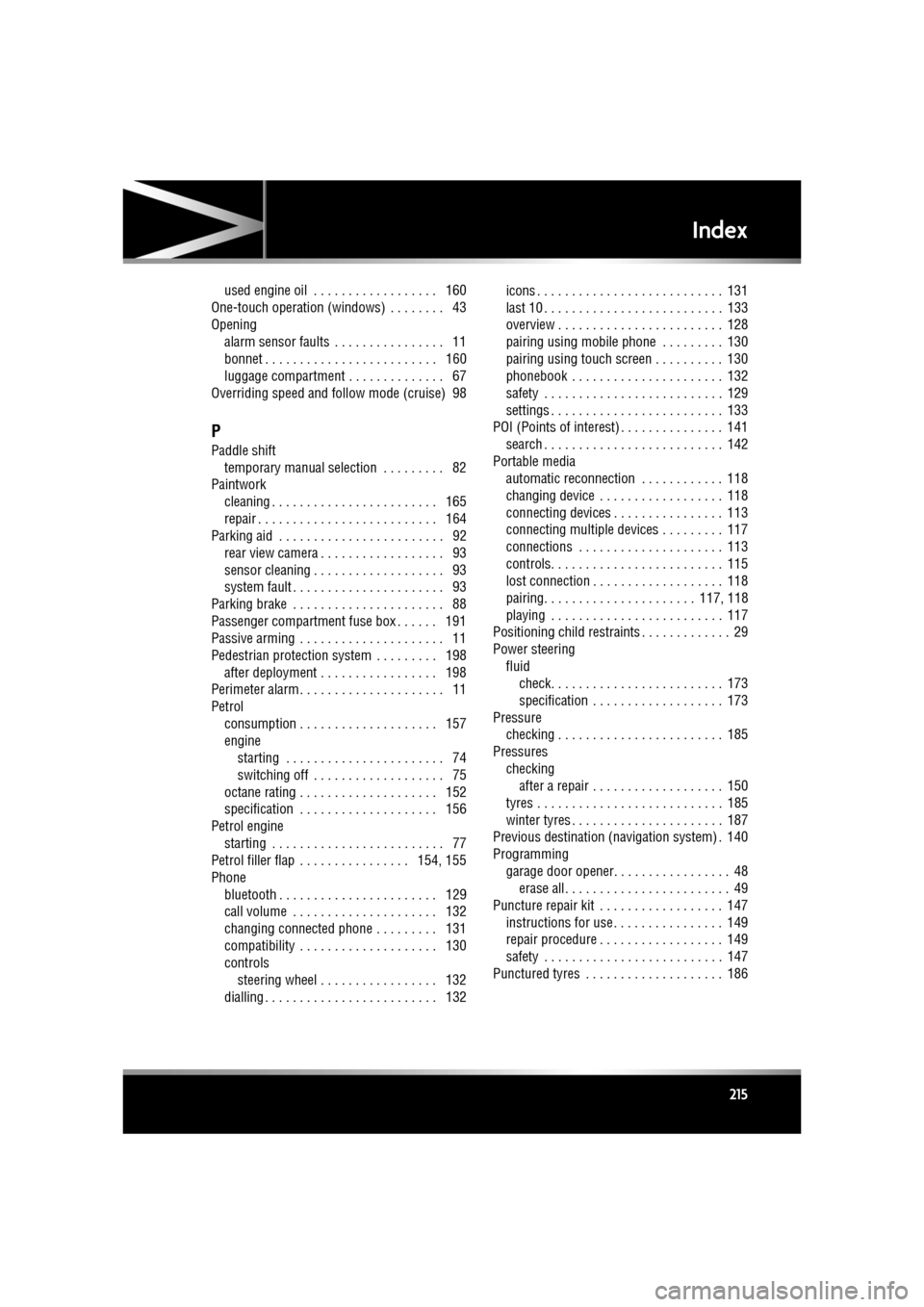
R
english-en (10, 18, 21 & 25)
Index
215
used engine oil . . . . . . . . . . . . . . . . . . 160
One-touch operation (windows) . . . . . . . . 43
Opening alarm sensor faults . . . . . . . . . . . . . . . . 11
bonnet . . . . . . . . . . . . . . . . . . . . . . . . . 160
luggage compartment . . . . . . . . . . . . . . 67
Overriding speed and follow mode (cruise) 98
P
Paddle shift temporary manual selection . . . . . . . . . 82
Paintwork cleaning . . . . . . . . . . . . . . . . . . . . . . . . 165
repair . . . . . . . . . . . . . . . . . . . . . . . . . . 164
Parking aid . . . . . . . . . . . . . . . . . . . . . . . . 92 rear view camera . . . . . . . . . . . . . . . . . . 93
sensor cleaning . . . . . . . . . . . . . . . . . . . 93
system fault . . . . . . . . . . . . . . . . . . . . . . 93
Parking brake . . . . . . . . . . . . . . . . . . . . . . 88
Passenger compartment fuse box . . . . . . 191
Passive arming . . . . . . . . . . . . . . . . . . . . . 11
Pedestrian protection system . . . . . . . . . 198
after deployment . . . . . . . . . . . . . . . . . 198
Perimeter alarm . . . . . . . . . . . . . . . . . . . . . 11
Petrol
consumption . . . . . . . . . . . . . . . . . . . . 157
enginestarting . . . . . . . . . . . . . . . . . . . . . . . 74
switching off . . . . . . . . . . . . . . . . . . . 75
octane rating . . . . . . . . . . . . . . . . . . . . 152
specification . . . . . . . . . . . . . . . . . . . . 156
Petrol engine starting . . . . . . . . . . . . . . . . . . . . . . . . . 77
Petrol filler flap . . . . . . . . . . . . . . . . 154, 155
Phone bluetooth . . . . . . . . . . . . . . . . . . . . . . . 129
call volume . . . . . . . . . . . . . . . . . . . . . 132
changing connected phone . . . . . . . . . 131
compatibility . . . . . . . . . . . . . . . . . . . . 130
controls
steering wheel . . . . . . . . . . . . . . . . . 132
dialling . . . . . . . . . . . . . . . . . . . . . . . . . 132 icons . . . . . . . . . . . . . . . . . . . . . . . . . . . 131
last 10 . . . . . . . . . . . . . . . . . . . . . . . . . . 133
overview . . . . . . . . . . . . . . . . . . . . . . . . 128
pairing using mobile phone . . . . . . . . . 130
pairing using touch screen . . . . . . . . . . 130
phonebook . . . . . . . . . . . . . . . . . . . . . . 132
safety . . . . . . . . . . . . . . . . . . . . . . . . . . 129
settings . . . . . . . . . . . . . . . . . . . . . . . . . 133
POI (Points of interest) . . . . . . . . . . . . . . . 141
search . . . . . . . . . . . . . . . . . . . . . . . . . . 142
Portable media automatic reconnection . . . . . . . . . . . . 118
changing device . . . . . . . . . . . . . . . . . . 118
connecting devices . . . . . . . . . . . . . . . . 113
connecting multiple devices . . . . . . . . . 117
connections . . . . . . . . . . . . . . . . . . . . . 113
controls. . . . . . . . . . . . . . . . . . . . . . . . . 115
lost connection . . . . . . . . . . . . . . . . . . . 118
pairing. . . . . . . . . . . . . . . . . . . . . . 117, 118
playing . . . . . . . . . . . . . . . . . . . . . . . . . 117
Positioning child restraints . . . . . . . . . . . . . 29
Power steering fluid check. . . . . . . . . . . . . . . . . . . . . . . . . 173
specification . . . . . . . . . . . . . . . . . . . 173
Pressure checking . . . . . . . . . . . . . . . . . . . . . . . . 185
Pressures checking after a repair . . . . . . . . . . . . . . . . . . . 150
tyres . . . . . . . . . . . . . . . . . . . . . . . . . . . 185
winter tyres . . . . . . . . . . . . . . . . . . . . . . 187
Previous destination (navigation system) . 140
Programming garage door opener. . . . . . . . . . . . . . . . . 48 erase all. . . . . . . . . . . . . . . . . . . . . . . . 49
Puncture repair kit . . . . . . . . . . . . . . . . . . 147 instructions for use . . . . . . . . . . . . . . . . 149
repair procedure . . . . . . . . . . . . . . . . . . 149
safety . . . . . . . . . . . . . . . . . . . . . . . . . . 147
Punctured tyres . . . . . . . . . . . . . . . . . . . . 186